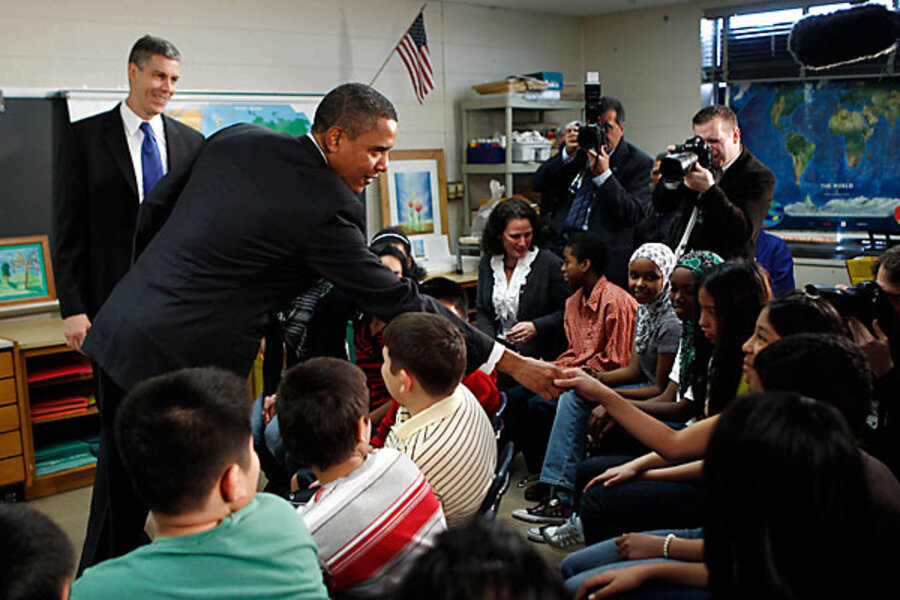Obama pushes to add $1.35 billion to Race to the Top grants
Loading...
| Chicago
As more than 30 states scrambled to submit their Race to the Top applications Tuesday, President Obama proposed continuing the competitive education grant program next year, with an additional $1.35 billion.
Under his proposal, the administration would also open up the competition to individual districts. Currently, only states can apply.
Race to the Top has already given the federal government an unusually strong influence in state education priorities. Numerous states including California and Michigan have made significant reforms to make their applications more attractive and to align their policies with the federal education agenda – a development that Mr. Obama highlighted in making his announcement at Virginia’s Graham Road Elementary School.
“By rewarding some of these states submitting applications today, by extending the Race to the Top for states, by launching a Race to the Top among school districts, and by applying the principles of Race to the Top to other federal programs, we’ll build on this success,” he said.
Revolt in the districts
Still, it’s far from assured that Congress will approve his request. The federal deficit is ballooning.
Moreover, Race to the Top is running into opposition at the local level. Many districts and unions are showing signs of discontent, with a significant number refusing to support their state’s bid for a grant.
In Michigan and Florida, for instance, teachers unions have recommended that districts not sign onto the applications. And in California and other states, hundreds of districts have done just that, refusing to sign their state's Race to the Top application because of concern about the proposed reforms and possible strings attached to the money.
One of the most controversial reforms is recent legislation in California that would give students at the poorest performing schools the right to cross districts, and would give parents as such schools the right to demand changes.
“This has become the big story over the past two to three weeks,” says Andy Smarick, an analyst at the Thomas B. Fordham Institute.
The unanswered question, he says, is how this lack of solidarity will affect states’ applications: Will the money will go to the states with more ambitious applications but less unanimity, or will it go to states with weaker applications but more uniform support?
“There’s a big rift between reform leaders and reform opponents, and it just can’t be breached,” says Mr. Smarick. “Race to the Top didn’t cause this rift, but it’s really exposed it.”
No money for the status quo
Secretary of Education Arne Duncan has emphasized that having a spirit of collaboration and buy-in from stakeholders will be important. But proposing less ambitious reforms to get that buy-in won’t earn states any points, he adds.
“If a state is getting consensus but doing it by driving the status quo, we won’t be that interested,” he said in a telebriefing. “But we’re confident that we’re going to have a set of states that are able both to push a strong reform agenda and get all the adults working together. Those are the states we’re going to invest in.”
The Department of Education hasn’t specified how many states will receive grants in this first round, but says that it will be highly competitive. Awards will be announced in April, and a second round of applications will be accepted in June.
Some states, like Maryland and Mississippi, have already said they will wait to submit an application in the second round. Texas, meanwhile, has announced that it will not submit any application, with Gov. Rick Perry (R) saying that the effort “smacks of a federal takeover of public schools.”
In announcing his hopes of opening up Race to the Top to individual districts, Obama singled out Texas’s opt-out stance as a reason, noting that “innovative districts like the one in Texas whose reform efforts are being stymied by state decisionmakers will soon have the chance to earn funding to help them pursue those reforms.”
Just the beginning?
The administration has also indicated that the program may be an ongoing one even past the next fiscal year, with a senior official saying that “you could envision this going on until we felt like we’ve made significant progress across the country.”
Such an extension, note some observers, would entail a significant shift in how the federal government involves itself in education.
“I generally applaud this administration’s policies, but I worry about it in terms of that degree of authority being given to a secretary of education,” says Russ Whitehurst, director of the Brown Center on Education Policy and a senior fellow at the Brookings Institution.
The original Race to the Top was conceived as a one-shot deal, he says, and has already had a big impact even before grants have been awarded.
“Now we see a shift to a strategy where the US Education Secretary will be able to control a pot of $1 billion a year…. That’s a remarkable shift in terms of the number of carrots in the basket that the federal government has to hand out.”
-----
Follow us on Twitter.





